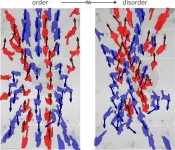(Press-News.org) Original Research
Background and Goal: Existing tools for cognitive impairment focus primarily on clinical diagnosis but do not support discussions that address patients’ personal fears, goals, and social needs.
Study Approach: Researchers conducted a feasibility study using a community and user-centered design approach to develop and test the “About Me” Care Card, a tool developed based on shared decision-making principles. An environmental scan identified gaps in existing cognitive care tools, and a global steering committee made up of health care professionals, patient advocacy groups, caregivers/family members, and individuals with dementia provided feedback.
Main Results Fourteen clinicians consisting of 7 clinician types across 7 institutions piloted the card during in-person visits or by telephone. Observations showed the card (1) allowed time to elicit what matters most to patients, (2) created space for personalized care conversations, (3) opened an examination of social care needs, and (4) moderated emotional relationships between families and individuals. Findings from 44 completed post-use surveys showed that most patients found the card beneficial, with 65% recommending it for those over age 65. However, while 41% found it easy to use, some patients with advanced cognitive challenges required assistance and only 32% felt it helped in creating a concrete plan to address their priorities.
Why It Matters: Findings from this study suggest that integrating tools like the “About Me” Care Card into primary care workflows could help clinicians identify patient concerns earlier.
Feasibility and Acceptability of the “About Me” Care Card as a Tool for Engaging Older Adults in Conversations About Cognitive Impairment
Stuart W. Grande, PhD, MPA, et al
University of Minnesota School of Public Health, Minneapolis, Minnesota
PERMANENT LINK
END
“About me” care card tool can improve care planning and cognitive health management
Feasibility and acceptability of the “about me” care card as a tool for engaging older adults in conversations about cognitive impairment
2025-03-24
ELSE PRESS RELEASES FROM THIS DATE:
Chi, Advincula named Materials Research Society Fellows
2025-03-24
Miaofang Chi and Rigoberto “Gobet” Advincula, both researchers at the Department of Energy’s Oak Ridge National Laboratory, have been elected as Class of 2025 Fellows of the Materials Research Society, or MRS. Chi also holds a joint appointment at Duke University, and Advincula is jointly appointed at the University of Tennessee, Knoxville.
The society, which has more than 13,000 members from 90 countries, selects Fellows for their distinguished accomplishments and outstanding contributions ...
Expectant and new fathers seek more support to improve maternal health
2025-03-24
PHILADELPHIA (March 24, 2025) – A new Penn Nursing study reveals that expectant and new fathers, particularly Black American fathers, express a significant need for more resources and support to better assist mothers during pregnancy and childbirth. The research, published in BMC Pregnancy and Childbirth, highlights a gap in tailored information and resources for fathers within healthcare and social service systems.
Researchers conducted focus groups with eighty new fathers across the United States, with the majority (86%) being Black American, to understand ...
5,700-year storm archive shows rise in tropical storms and hurricanes in the Caribbean
2025-03-24
FRANKFURT. In the shallow waters of the Lighthouse Reef Atoll, located 80 kilometers off the coast of the small Central American country of Belize, the seabed suddenly drops steeply. Resembling a dark blue eye surrounded by coral reefs, the “Great Blue Hole” is a 125-meter-deep underwater cave with a diameter of 300 meters, which originated thousands of years ago from a karst cave located on a limestone island. During the last ice age, the cave’s roof collapsed. As ice sheets melted and global sea level started to rise, the cave ...
The secret behind pedestrian crossings – and why some spiral into chaos
2025-03-24
UNDER EMBARGO UNTIL MONDAY, MARCH 24, 2025 (3:00 PM U.S. Eastern time)
Pedestrian crossings generally showcase the best in pedestrian behaviour, with people naturally forming orderly lanes as they cross the road, smoothly passing those coming from the opposite direction without any bumps or scrapes. Sometimes, however, the flow gets chaotic, with individuals weaving through the crowd on their own haphazard paths to the other side.
Now, an international team of mathematicians, co-led by Professor Tim Rogers at the University of Bath in the UK and Dr Karol Bacik at MIT in ...
Organic molecules of unprecedented size discovered on Mars
2025-03-24
The longest organic molecules identified to date on Mars have recently been detected by scientists from the CNRS1, together with their colleagues from France, the United States of America, Mexico and Spain. These long carbon chains, containing up to 12 consecutive carbon atoms, could exhibit features similar to the fatty acids produced on Earth by biological activity2. The lack of geological activity and the cold, arid climate on Mars have helped preserve this invaluable organic matter in a clay-rich sample for the past 3.7 billion years. It therefore dates from the period during which life first emerged on Earth. These findings ...
Mathematicians uncover the logic behind how people walk in crowds
2025-03-24
Next time you cross a crowded plaza, crosswalk, or airport concourse, take note of the pedestrian flow. Are people walking in orderly lanes, single-file, to their respective destinations? Or is it a haphazard tangle of personal trajectories, as people dodge and weave through the crowd?
MIT instructor Karol Bacik and his colleagues studied the flow of human crowds and developed a first-of-its-kind way to predict when pedestrian paths will transition from orderly to entangled. Their findings may help inform the design of public spaces that promote safe and efficient thoroughfares.
In a paper appearing in the Proceedings of the National Academy ...
Zoom bias: The social costs of having a ‘tinny’ sound during video conferences
2025-03-24
New Haven, Conn. — Most job candidates know to dress nicely for Zoom interviews and to arrange a professional-looking background for the camera. But a new Yale study suggests they also ought to test the quality of their microphones.
A tinny voice caused by a cheap mic, researchers say, could sink their chances.
Through a series of experiments, the study demonstrates that tinny speech — a thin, metallic sound — during video conferences can have surprisingly deep social consequences, leading listeners to lower their judgments of a speaker’s intelligence, credibility, and romantic desirability. ...
Biologists discover ancient neurohormone that controls appetite
2025-03-24
A team of biologists at Queen Mary University of London has discovered that a neurohormone controlling appetite in humans has an ancient evolutionary origin, dating back over half a billion years. The findings, published in Proceedings of the National Academy of Sciences USA, reveal that this satiety-inducing molecule, known as bombesin, is not only present in humans and other vertebrates but also in starfish and their marine relatives.
Bombesin, a small peptide, plays a key role in regulating hunger by signalling when we’ve had enough to eat. But its story doesn’t start with humans or even mammals. New research shows that ...
The right moves to reign in fibrosis
2025-03-24
By Leah Shaffer
The cells in human bodies are subject to both chemical and mechanical forces. But up until recently, scientists have not understood much about how to manipulate the mechanical side of that equation. That’s about to change.
“This is a major breakthrough in our ability to be able to control the cells that drive fibrosis,” according to Guy Genin, the Harold and Kathleen Faught Professor of Mechanical Engineering in the McKelvey School of Engineering at Washington University in St. Louis, speaking of research recently published in Nature Materials.
Fibrosis is an affliction wherein ...
Exploring why it is harder to hear in noisy environments
2025-03-24
Imagine trying to listen to a friend speak over the commotion of a loud party. It is difficult to detect and process sounds in noisy environments, especially for those with hearing loss. Previous research has typically focused on how competing sounds influence cortical brain activity, with the end goal of informing treatment strategies for people who are hard of hearing. But in a new eNeuro study, Melissa Polonenko and Ross Maddox, from the University of Rochester, explored a lesser-studied influence of competing sounds on subcortical brain ...
LAST 30 PRESS RELEASES:
University of Oklahoma researcher awarded funding to pursue AI-powered material design
Exploring how the visual system recovers following injury
Support for parents with infants at pediatric check-ups leads to better reading and math skills in elementary school
Kids’ behavioral health is a growing share of family health costs
Day & night: Cancer disrupts the brain’s natural rhythm
COVID-19 vaccination significantly reduces risk to pregnant women and baby
The role of vaccination in maternal and perinatal outcomes associated with COVID-19 in pregnancy
Mayo Clinic smartwatch system helps parents shorten and defuse children's severe tantrums early
Behavioral health spending spikes to 40% of all children’s health expenditures, nearly doubling in a decade
Digital cognitive behavioral treatment for generalized anxiety disorder
Expenditures for pediatric behavioral health care over time and estimated family financial burden
Air conditioning in nursing homes and mortality during extreme heat
The Alps to lose a record number of glaciers in the next decade
What makes a good proton conductor?
New science reporting guide published for journalists in Bulgaria
New international study reveals major survival gaps among children with cancer
New science reporting guide published for journalists in Turkey
Scientists develop a smarter mRNA therapy that knows which cells to target
Neuroanatomy-informed brain–machine hybrid intelligence for robust acoustic target detection
Eight SwRI hydrogen projects funded by ENERGYWERX
The Lundquist Institute and its start-up company Vitalex Biosciences Announces Strategic Advancement of Second-Generation fungal Vaccine VXV-01 through Phase 1 Trials under $40 Million Competitive Con
Fine particles in pollution are associated with early signs of autoimmune disease
Review article | Towards a Global Ground-Based Earth Observatory (GGBEO): Leveraging existing systems and networks
Penn and UMich create world’s smallest programmable, autonomous robots
Cleveland researchers launch first major study to address ‘hidden performance killer’ in athletes
To connect across politics, try saying what you oppose
Modulating key interaction prevents virus from entering cells
Project explores barriers to NHS career progression facing international medical graduates
Jeonbuk National University researchers explore the impact of different seasonings on the flavor perception of Doenjang soup
Two Keck Medicine of USC Hospitals named Leapfrog Top Teaching Hospitals
[Press-News.org] “About me” care card tool can improve care planning and cognitive health managementFeasibility and acceptability of the “about me” care card as a tool for engaging older adults in conversations about cognitive impairment





